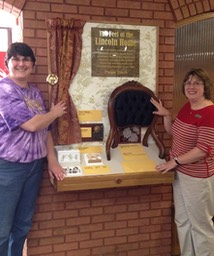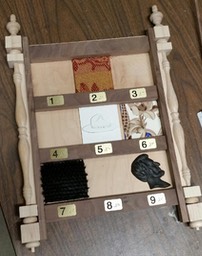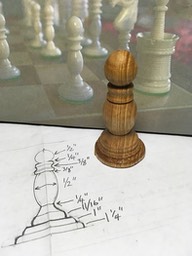- Fake Dirt Recipe
- Sensory Book Prototype for the Lincoln Home
- Previous Mound Builders exhibit redesigned at Cahokia Mounds
- Exhibit Updates at Cahokia Mounds
- Illinois Amish Heritage Center
- RES Helps Sculptor Win Commission
- NPS Award
- The Feel of the Lincoln Home
- Old Robotman Feels Close to Home
- Fabricating plants for the Wetlands and Waterways diorama
Fake Dirt Recipe
Since I get requests for this from my former students at least once or twice a year, I thought I should make one of the first blog entries my "fake dirt" recipe. Several classes have used this recipe for their exhibit project. It is very versatile, and I have even used it on vertical surfaces. And it has obvious benefits over using real dirt in galleries.
FAKE DIRT RECIPE
The recipe should cover an area approximately 4’ X 6’
1 bag of sand (buy wash sand instead of sandbox sand. It’s cheaper and dirtier, but hey, that’s what we’re making)
Instead of sand you can substitute powdered potter’s clay. It depends on what kind of dirt you want to make, sand-like or clay-like. You can also use both in proportion to the kind of dirt you desire.
1-gallon carpenter’s glue
Water
Sawdust
Water-base paint (optional)
Mix up the sand and/or clay and sawdust in a wheelbarrow with a hoe in roughly equal parts. You probably won’t use a whole bag of sand, but just make enough so that when you mix it up, it’s not spilling over the top of the wheelbarrow. Keep adding water and glue in equal parts and mix until the consistency of wet cement, thoroughly wet, but not runny. If you need certain color dirt, you can add paint to change the darkness and/or color. A little paint goes a long way. Just add a little at a time, like a cupful. Remember, the dirt will dry darker, too.
Staple 1-inch mesh chicken wire to the surface where dirt is to be applied. Trowel on enough dirt to cover the wire. It may take 2-3 days to dry, so don’t wait until the last minute before making it. If you didn’t mix enough, just repeat the process. Ideally, you shouldn’t trowel it on in the gallery because water can seep out. It will be heavy to move when dry, but better safe than sorry.
Sensory Book Prototype for the Lincoln Home
In 2015 RES produced a hands-on exhibit for the Visitor Center at the Lincoln Home National Historic Site. It allows visitors to touch objects similar to ones they would see (but not touch) while touring the Lincoln Home. It won an accessibility award from the National Park Service.
Now the LHNHS has asked RES to design a prototype “Sensory Book” that visitors with disabilities can carry with them on the house tour. Now in the production phase, the original concept called for nine pages, each with a different object. When this proved to be too cumbersome, the design changed to a board with nine braille numbered objects. Our new “Sensory Board” has reproduction objects from the site, purchased objects, and some made by RES (like the chess piece).
So, when the tour guide (park ranger) is in the living room and discussing the carpet, drapery, horsehair fabric on the furniture, or wood turnings on a chair, the visitor can actually feel those objects on the Sensory Board.
The Site plans to test the prototype after there’s a corona virus vaccine. Data gathered during the testing period will inform RES of any changes to be made in the Sensory Board for for final production.
Previous Mound Builders exhibit redesigned at Cahokia Mounds
RES gets mentioned in the Winter 2020 issue of the Cahokian for its help in the design and installation of a flip book with a map and 9 other interpretive panels of prehistoric sites with earthen mounds in the US.
Exhibit Updates at Cahokia Mounds
RES is mentioned in the Spring 2019 issue of Cahokian. We are working with staff archaeologist, Bill Iseminger, to upgrade interpretive material based on new archaeological research of Mound 72.
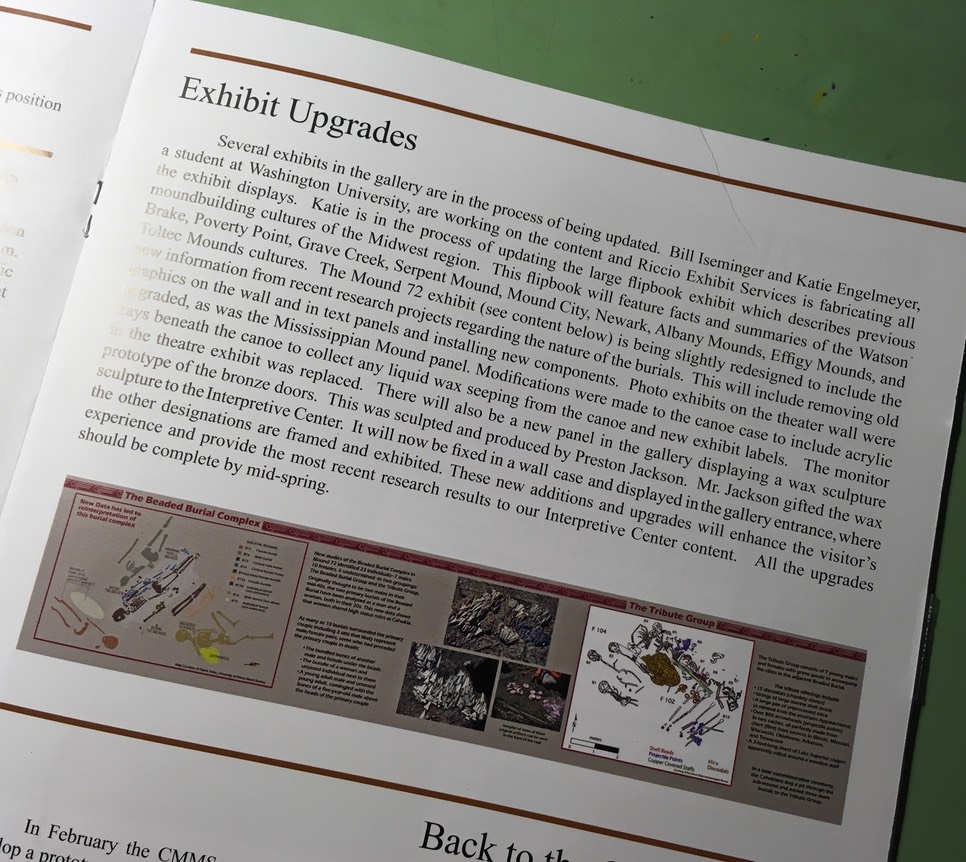
Illinois Amish Heritage Center
RES fabricated this 59” X 31.75” N-scale model for the Illinois Amish Heritage Center. Three of the six historic buildings have already been moved to the site just east of Arthur, Illinois on Ill. Rte. 133. The model will be used to raise funds to move and restore the buildings and to build a new museum and exhibitions. The museum building lifts up to reveal the proposed floor plan.
RES Helps Sculptor Win Commission
I am pleased to let you know that I received a call from the Norman, Oklahoma selection committee yesterday advising me that I have been selected for their library commission. They advised me that one of the factors that contributed to selecting me for the commission was the model of the library. They were impressed with its overall quality and ability to let them envision how the sculpture would relate to the library.
Thanks for you(r) good work,
Jim Johnson
email message May 23, 2017
NPS Award
The National Park Service granted the exhibit “The Feel of the Lincoln Home” a 2015 exhibit accessibility award. We are honored to have been the exhibit firm that developed this exhibit with the staff at the Lincoln Home. You can see it in their Visitor Center in Springfield.
The Feel of the Lincoln Home
At the end of May 2015, RES installed a new hands-on exhibit at the Lincoln Home National Historic Site in Springfield, Illinois. Originally intended for the visually impaired, “The Feel of the Lincoln Home”, installed in the site’s Visitor Center, allows all visitors to touch objects like they will see, but not be able to touch, in the Lincoln Home. It includes Braille Labels for the blind, but its hands-on activities appeal to all audiences. It won a National Park Service award for accessibility.
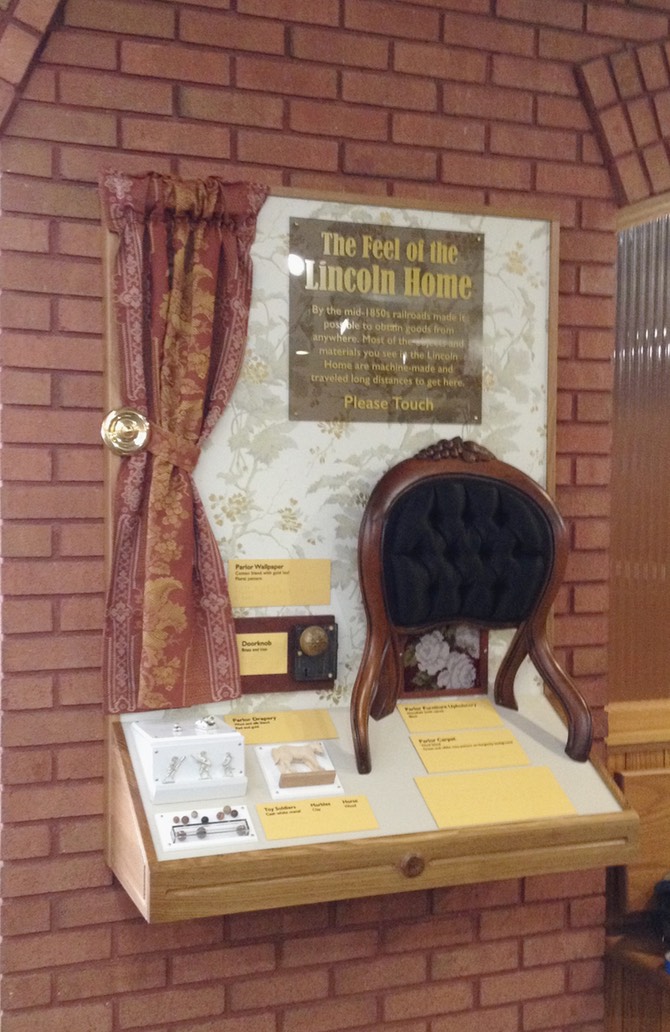
Old Robotman Feels Close to Home
Jim Meddick’s old comic strip, Robotman, hits pretty close to home for Gary and me after working on the diorama at Cahokia Mounds for the past year. Maybe they should add some new postcards in their gift shop, too.
Fabricating plants for the Wetlands and Waterways diorama
The fabrication of plants plays a major role in making most dioramas look as realistic as possible. Sometimes you can find good representations of plants through artificial plant companies. But most of the time you will have to make modifications to some part of the plant depending on the particular requirements of your diorama. In other cases where no artificial specimen is available, you will have to make the plant from scratch. Although we are employing several techniques for the diorama in the Cahokia Mounds exhibit, “Wetlands and Waterways: The Key to Cahokia”, we are having some success with a method that diorama artist, Gary Hoyle, mentioned in his blog. He suggested making plant leaves out of paper. So, we start by collecting specimens from nature. We then scan multiple leaf types from each specimen. I scan the top side and then make a copy and flip and lighten the image for the underside. I apply positional mounting adhesive (PMA) to one side. Then before I line up the other side, I insert a wire down the middle of each leaf to attach to the main stem.
The other problem we had to solve was the issue of aging. Since paper tends to yellow and dye inks tend to fade over time, we’ve had to use paper and inks that are archival quality. Epson makes several lines of printers that use pigment inks which have been tested to last for decades without fading. Epson also makes a line of Fine Art papers that are acid-free and made of 100% cotton. They come in smooth or textured and bright white or natural. We are still experimenting to determine which papers work best for each leaf type. Dioramas will always be labor-inntensive endeavors, but the level of realism and the longevity achieved with this method, makes it a viable option to other plant fabrication techniques.
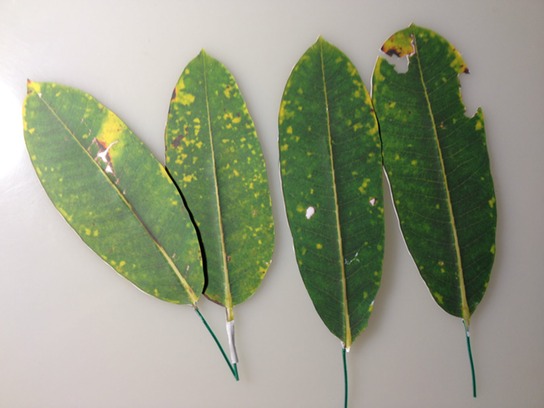
Artificial milkweed Leaves
